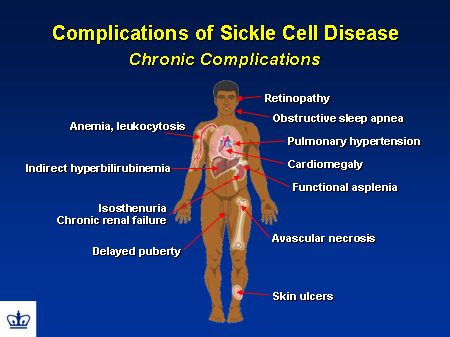
Sickle Cell Disease is a blood disease that affects red bloods cells
People with sickle cell disease have high red blood cell counts, but with very low red blood cell fibrinogen content. Sometimes, these red cells have abnormal form (crescent shape) and are difficult to pass through small blood vessels. This makes them extremely vulnerable to infection.
Most people who have it don't show any symptoms, but they do suffer from chronic fatigue and other serious symptoms such as anemia, a weakened immune system and a rapid build up of lactic acid in the body. When the blood contains too much lactic acid, it can damage heart tissue and cause myocardial infarction, a heart attack. When the blood contains too little fibrinogen, it can also damage the blood vessels and create scar tissue, which is what causes varicose veins and spider veins.
Sickle cells are caused when one or more of the hemoglobin types, or types of hemoglobin, change in a person's body. For example, hemoglobin A, which is responsible for carrying oxygen to the muscles, becomes abnormal. It can be caused by damage caused by radiation or genetic abnormalities.
When the blood carries more hemoglobin A than necessary, it becomes sickled (the condition occurs when the cells in the blood become thicker than they should be), which causes the sickling of blood cells, which leads to more sickles. There are many different variations of sickle cells disease, and each has their own specific symptom and cause.
Although there are no known cures for sickle disease, there are several ways to control its onset and symptoms. Some people may be able to prevent it completely, by not picking or eating red or black blood-forming vegetables, and some may experience mild cases of sickling, which can usually be reduced with certain medications.
People who already have sickle disease usually have to take stronger drugs to treat their symptoms. There is currently no cure for sickling, but researchers are looking at various treatments that can reduce its severity and lessen the effects it has on the heart. People with sickling also need to watch out for dangerous bleeding, and bleeding gums. which may also may bleed. although rare, if the sickling occurs in the bone marrow of the bone, the treatment may have an effect on the bones. and may lead to deformity. if the blood is not passed away, it could lead to anemia. This may lead to weakness and lack of energy and may make it difficult to work or even breathe. depending on the level of damage to the affected bone. The side effects of sickling may vary depending on the type of disease and cause.
The most common symptom associated with this condition is fatigue
The condition can affect the brain, liver, kidneys, spleen, and lungs. Other effects include high fever, fever, abdominal pain, increased thirst, yellowish skin tone, weight loss, nausea, vomiting, diarrhea, sweating, abdominal cramps, headaches, anemia, and chest pain.
At the first appearance of any of the above symptoms, you should consult your doctor and read บล็อกสุขภาพและยาที่ดีที่สุด. If you notice any of these symptoms, or if your symptoms do not respond to treatment, it is best to seek medical attention right away.
Sickle cell disease is caused by the body being unable to break down a blood clot. It occurs because the body doesn't get rid of blood cells that it doesn't need. When you don't use a clot of blood to replace itself, it forms a blood clot in the vein and travels to the lungs, then travels through the heart. through the brain and into the kidneys. The body can sometimes be able to break up a blood clot so that it will pass through the heart and circulate in the blood stream, but often, this can take several hours or even days. and the body can't break them all off and pass them out through the body. So, instead of getting rid of them, they stay in one place and start accumulating.
When the heart is unable to break up a clot, it can start to damage the bone marrow. This damage causes the heart to work harder and produce less of the proteins that it needs to function properly. In some cases, the damage to the bone marrow can lead to heart failure and death. So, if you have sickling or experience symptoms, your doctor will want to do tests to find out if your heart is healthy or not.
In rare cases, doctors will perform a bone marrow transplant to treat sickle cells disease. A doctor will also have to know what kind of treatment is recommended based on the location of the tumor.